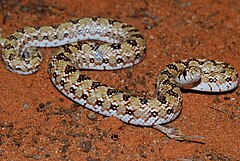Lamprophiidae
| Lamprophiidae | |
|---|---|

| |
| Boaedon capensis | |
| Scientific classification | |
| Domain: | Eukaryota |
| Kingdom: | Animalia |
| Phylum: | Chordata |
| Class: | Reptilia |
| Order: | Squamata |
| Suborder: | Serpentes |
| Superfamily: | Elapoidea |
| Family: | Lamprophiidae Fitzinger, 1843 |
| Subfamilies | |
The Lamprophiidae are a family of snakes[1] found mostly in Africa, but also in parts of southern Europe and western Asia.[2] A few species reach southeastern Asia. There are 314 species as of May 2018.[3]
Biology
Lamprophiids are a very diverse group of snakes. Many are terrestrial but some are fossorial (e.g. Amblyodipsas), arboreal (e.g. Langaha), or semi-aquatic (e.g. Lycodonomorphus). Some are fast-moving (e.g. Psammophis) whereas others are slow (e.g. Duberria). They are found in deserts, grasslands, temperate and tropical forests, steppes and mountains. Together they feed on mammals, birds, reptiles, amphibians, fish, and invertebrates. Some species use constriction to subdue their prey (e.g. Boaedon), whereas others are highly venomous and dangerous to humans (e.g. Atractaspis). Tooth morphology within Lamprophiidae is probably more variable than within any other snake family. Most species are oviparous.
Classification
Most lamprophiids were historically considered to be members of the subfamily Lamprophiinae in the family Colubridae. The following classification follows Pyron et al., 2010[2], whose finding that lamprophiids are more closely related to elapids has been repeated by several other studies.[4][5][6][7] Together these two groups are sometimes referred to as the Elapoidea. In fact, some studies have found that Elapidae is nested within Lamprophiidae[6][7], a finding that, if confirmed, will likely necessitate taxonomic changes to restore monophyly within the Elapoidea.
List of subfamilies and genera



- Incertae sedis[1]
- Cyclorinae Weinell and Brown, 2017
- Cyclocorus Duméril & Bibron, 1853
- Hologerrhum Günther, 1858
- Montaspis Bourquin, 1991
- Oxyrhabdium Boulenger, 1893
- Aparallactinae Bourgeois, 1968[1][8] (sometimes considered part of Atractaspidinae)
- Amblyodipsas W. Peters, 1857
- Aparallactus A. Smith, 1849
- Brachyophis Mocquard, 1888
- Chilorhinophis F. Werner, 1907
- Hypoptophis Boulenger, 1908
- Macrelaps Boulenger, 1896
- Micrelaps Boettger, 1880
- Polemon Jan, 1858
- Xenocalamus Günther, 1868
- Atractaspidinae Günther, 1858[1][8]
- Atractaspis A. Smith, 1849
- Homoroselaps Jan, 1858
- Lamprophiinae Fitzinger, 1843[1][8]
- Boaedon A.M.C. Duméril, Bibron & A.H.A. Duméril, 1854
- Bothrolycus Günther, 1874
- Bothrophthalmus W. Peters, 1863
- Chamaelycus Boulenger, 1919
- Dendrolycus Laurent, 1956
- Gonionotophis Boulenger, 1893
- Hormonotus Hallowell, 1857
- Inyoka Kelly, Branch, Broadley, Barker & Villet, 2011
- Lamprophis Fitzinger, 1843
- Lycodonomorphus Fitzinger, 1843
- Lycophidion Fitzinger, 1843
- Pseudoboodon Peracca, 1897
- Prosymninae Kelly, Barker, Villet & Broadley, 2009[1][8]
- Psammophiinae Dowling, 1967[1][8]
- Dipsina Jan, 1862
- Hemirhagerrhis Boettger, 1893
- Malpolon Fitzinger, 1826
- Mimophis Günther, 1868
- Psammophis Fitzinger, 1826
- Psammophylax Fitzinger, 1843
- Rhagerhis W. Peters, 1862
- Rhamphiophis W. Peters, 1854
- Pseudaspidinae Cope, 1893[1][8]
- Pseudaspis Fitzinger, 1843
- Pythonodipsas Günther, 1868
- Pseudoxyrhophiinae Dowling, 1975[1][8]
- Alluaudina Mocquard, 1894
- Amplorhinus A. Smith, 1847
- Brygophis Domergue & Bour, 1989
- Compsophis Mocquard, 1894
- Ditypophis Günther, 1881
- Dromicodryas Boulenger, 1893
- Duberria Fitzinger, 1826
- Elapotinus Jan, 1862
- Heteroliodon Boettger, 1913
- Ithycyphus Günther, 1873
- Langaha Bonnaterre, 1790
- Leioheterodon Boulenger, 1893
- Liophidium Boulenger, 1896
- Liopholidophis Mocquard, 1904
- Lycodryas Günther, 1879
- Madagascarophis Mertens, 1952
- Micropisthodon Mocquard, 1894
- Pararhadinaea Boettger, 1898
- Parastenophis Nagy, Glaw & Vences, 2010
- Phisalixella Nagy, Glaw & Vences, 2010
- Pseudoxyrhopus Günther, 1881
- Thamnosophis Jan, 1863
References
- ^ a b c d e f g h i "Lamprophiidae - Die Systematik". www.dahmstierleben.de.
- ^ a b Pyron RA, Burbrink FT, Colli GR, Montes de Oca AN, Vitt LJ, Kuczynski CA, Wiens JJ. 2010. The phylogeny of advanced snakes (Colubroidea), with discovery of a new subfamily and comparison of support methods for likelihood trees. Molecular Phylogenetics and Evolution 58: 329–342. Archived 2013-12-03 at the Wayback Machine
- ^ Uetz, Peter. "Lamprophiidae". The Reptile Database. Retrieved May 18, 2018.
- ^ Pyron, R. A.; Burbrink, F.; Wiens, J. J. (2013). "A phylogeny and revised classification of Squamata, including 4161 species of lizards and snakes". BMC Evolutionary Biology. 13: 93.
- ^ Streicher, J. W.; Ruane, S. (2018). "Phylogenomics of Snakes". eLS. doi:10.1002/9780470015902.a0027476.
- ^ a b Figueroa, A.; McKelvy, A. D.; Grismer, L. L.; Bell, C. D.; Lailvaux, S. P. (2016). "A species-level phylogeny of extant snakes with description of a new colubrid subfamily and genus". PLoS ONE. 11: e0161070.
- ^ a b Zheng, Y; Wiens, JJ (2016). "Combining phylogenomic and supermatrix approaches, and a time-calibrated phylogeny for squamate reptiles (lizards and snakes) based on 52 genes and 4162 species" (PDF). Molecular Phylogenetics and Evolution. 94: 537–547.
- ^ a b c d e f g The Reptile Database. www.reptile-database.org.
Further reading
- Fitzinger L. 1843. Systema Reptilium, Fasciculus Primus, Amblyglossae. Vienna: Braumüller & Seidel. 106 pp. + indices.([1]).
External links
 Data related to Lamprophiidae at Wikispecies
Data related to Lamprophiidae at Wikispecies
